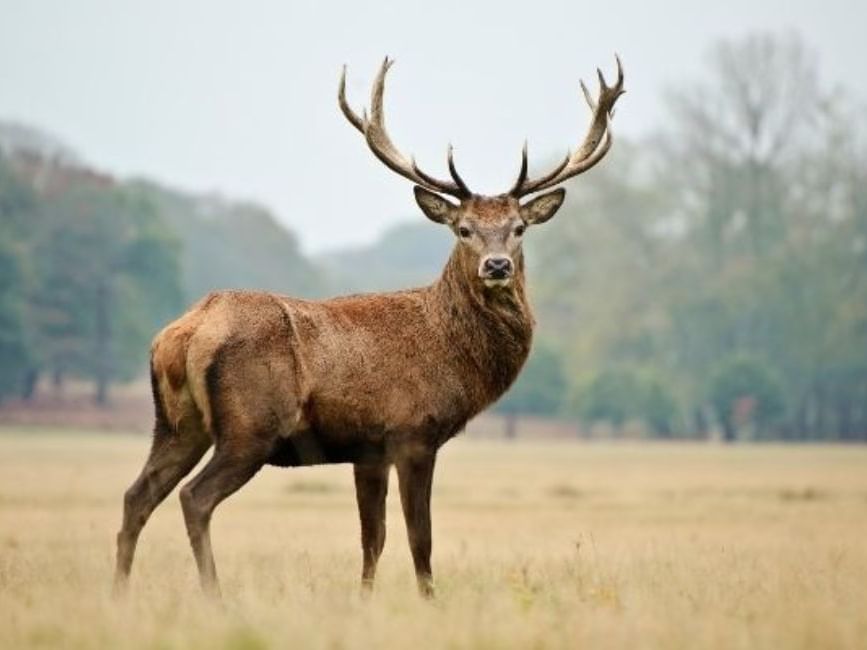UK Deer Species: The 6 Types Of UK Deer [Explained]
When it comes to English wildlife, the deer is perhaps one of the most iconic, and in terms of UK Deer Species, there are actually numerous different types of deer that come in a variety of shapes and sizes.
With this in mind, we’ve come up with some key features of the six most common UK Deer Species in our handy guide plus we reveal all about the deer that we have here roaming the Easthampstead Park grounds.
We hope you enjoy the read.
Chinese Water Deer
If you’ve never seen one before, Chinese water deer can be quite the sight to behold; however, unlike other deer in England, they do not have any antlers. Instead, Chinese water deer have prominent tusks. These sharp tusks, coupled with their small build and large, oval-shaped ears, can give them a rather peculiar appearance somewhat akin to a vampiric teddy bear.
Fallow Deer
Fallow deer are perhaps the most well-known British deer species, thanks to their massive, broad, flat antlers and distinctive spotted coat. They are roughly the same size as Sika deer but come in four different coat variations, including the common tan/fawn colouring, as well as menil (a paler coat), melanistic (almost entirely black), or white (with a very pale, sandy coat). In a tiny handful of cases, fallow deer may even be born albino.
Muntjac Deer
You’d be forgiven for questioning that the tiny muntjac deer is even a species of deer at all – and are often only 16kg or less at maturity, giving them a very small and sweet appearance. However, they are also among the most distinctive English deer for their backwards-pointing horns and large, oval-shaped ears.
Roe Deer
Small and nimble, roe der only grow to – at most – 25kg, but their exceptional speed and grace mean you may only catch a passing glimpse. They typically have small antlers compared to other deer species with many nodules, making them distinctive overall.
Red Deer
If you come across a towering deer during your travels in England, chances are it’s a red deer. Weighing anywhere up to 190kg for adult stags, with a massive rack of wide antlers. Red deer are also recognisable for their rich, auburn-red coats; however, other than this, they typically have no uniquely distinguishing features. They are also much shorter-lived than other deer species in the United Kingdom.
Sika Deer
The Sika deer is perhaps most iconic for its size and – in the case of the stags – awe-inspiring set of antlers. They can weigh up to 70kg in weight and look quite similar to fallow deer during the summer; however, you can usually recognise a Sika deer for the distinctive dark brown/black stripe along their backs. They also have a white rump.
Deer At Easthampstead Park
At Easthampstead Park, we’re fortunate to have Roe Deer in our grounds, and we take great care to preserve their habitat.
We recognise the importance of supporting the ecology that surrounds our property, which is why we are proud to be involved with the Woodland Trust, a charity that protects and restores woodland across the UK.
As we learned more about the different deer species in England, we were struck by the unique features and characteristics of each species and we’re grateful to be able to witness these beautiful creatures in their natural habitat and appreciate the important role they play in the local ecosystem.
Our Ecological Pledge As A Socially Responsible Company
At Easthampstead Park, we believe in doing our part to support the environment and the animals that call it home. Our involvement with the Woodland Trust is just one way we can contribute to preserving the natural beauty around us.
We encourage everyone to take an interest in the wildlife and ecology of their local area and to find ways to support and protect it. Together, we can make a real difference in the world around us.
For more info on what we’re doing and our ethos on the topic of Social Responsibility please visit our website and check out our GREEN PAGE.
Thanks for reading. If you've enjoyed this article and share our passion for animals, we invite you to explore more fascinating species that call Easthampstead Park home, like the slow worm.
